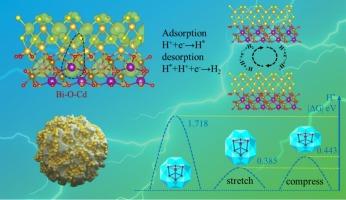BiFeO3@CdS异质结外场诱导压电光催化析氢
IF 5.5
2区 材料科学
Q1 MATERIALS SCIENCE, CHARACTERIZATION & TESTING
引用次数: 0
摘要
在这项工作中,我们通过创新的核壳结构设计合成了s型BiFeO3@CdS异质结压电光催化剂。在超声和可见光的协同作用下,系统地研究了它们的高效析氢性能。核壳结构BiFeO3@CdS-1在4 h内具有1704 μmol g−1的压电光催化析氢速率,分别是单光照射和压电条件下的4.19和8.52倍。综合表征(XPS, SPV和电化学分析等)证实在异质结界面处形成了有效的电荷转移通道,从而促进了电子-空穴对的空间分离。结合密度泛函理论(DFT)计算,我们证明了压电诱导的内置电场和异质结的界面电场显著降低了析氢反应的能垒,提高了载流子分离效率。本研究提出了一种结合界面工程和压电光催化设计高效稳定析氢催化剂的新策略。本文章由计算机程序翻译,如有差异,请以英文原文为准。

External field induced piezo-photocatalytic hydrogen evolution for BiFeO3@CdS heterojunction
In this work, we synthesized S-type BiFeO3@CdS heterojunction piezo-photocatalysts through an innovative core-shell structure design. Their efficient hydrogen evolution performances were systematically investigated under the synergistic effect of ultrasound and visible light irradiation. The core-shell-structured BiFeO3@CdS-1 exhibits a remarkable piezo-photocatalytic hydrogen evolution rate of 1704 μmol g−1 within 4 h, which is 4.19 and 8.52 times higher than those achieved under sole light irradiation and piezoelectric conditions, respectively. Comprehensive characterizations (XPS, SPV, and electrochemical analyses etc) confirm the formation of efficient charge transfer channels at the heterojunction interface, thereby promoting the spatial separation of electron-hole pairs. By combining density functional theory (DFT) calculations, we demonstrate that the piezoelectricity-induced built-in electric field and the interfacial electric field of the heterojunction significantly reduces the energy barrier for the hydrogen evolution reaction and enhanced carrier separation efficiency. This work presents a novel strategy for designing highly efficient and stable hydrogen evolution catalysts through the integration of interface engineering and piezo-photocatalysis.
求助全文
通过发布文献求助,成功后即可免费获取论文全文。
去求助
来源期刊

Materials Characterization
工程技术-材料科学:表征与测试
CiteScore
7.60
自引率
8.50%
发文量
746
审稿时长
36 days
期刊介绍:
Materials Characterization features original articles and state-of-the-art reviews on theoretical and practical aspects of the structure and behaviour of materials.
The Journal focuses on all characterization techniques, including all forms of microscopy (light, electron, acoustic, etc.,) and analysis (especially microanalysis and surface analytical techniques). Developments in both this wide range of techniques and their application to the quantification of the microstructure of materials are essential facets of the Journal.
The Journal provides the Materials Scientist/Engineer with up-to-date information on many types of materials with an underlying theme of explaining the behavior of materials using novel approaches. Materials covered by the journal include:
Metals & Alloys
Ceramics
Nanomaterials
Biomedical materials
Optical materials
Composites
Natural Materials.
 求助内容:
求助内容: 应助结果提醒方式:
应助结果提醒方式:


